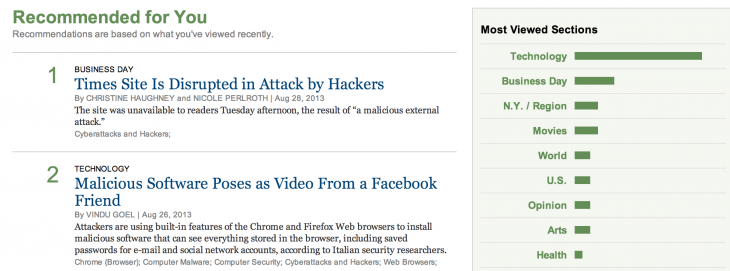
The New York Times has updated its personalized recommendation engine to include real-time article tracking across mobile apps and both the mobile and desktop websites, as noticed by Nieman Lab.
Other additions to the feature include video and slideshow recommendations, the Times’ employees indicated on Twitter. The engine will also index more of customers’ reading histories to arrive at its suggestions.
The recommendations aren’t yet available from within the mobile apps, though readers can access them on the mobile website if they login. Of course, if you want the engine to keep track of your preferences across all the devices you use, you’ll need to make sure you’re logged into the same account on each of them.
At least for me, the tool is quite accurate. My browsing history informs the newspaper that I read technology stories by a wide margin, so it surfaced stories about the fall of BlackBerry and Samsung’s upcoming smartwatch. Stories that I read while researching this article were quickly added to my history and then taken into consideration for new suggestions. In the long-term, I’ll probably want to login and let the Times start associating my reading history with my account, as currently my most viewed topics is being skewed by a couple errant articles I read earlier this week.

Personalized recommendations are becoming increasingly advanced and uncannily accurate as third-party services like Gravity and Outbrain have made strides in the field. However, the addition of an external service also opens up another vulnerability, as Outbrain’s customers witnessed earlier in August when the Syrian Electronic Army (SEA) made its way into the company’s dashboard and defaced sites like CNN and the Washington Post. The SEA even tweeted that it had been about to modify The New York Times’ account before Outbrain pulled shut down its service.
Earlier this week, the SEA did manage to find a way to take down the Times’ website, this time through its domain registrar Melbourne IT. Twitter was also affected by the incident.
➤ The New York Times personalized recommendations
Image credit: Timothy A. Clary for AFP / Getty Images
Get the TNW newsletter
Get the most important tech news in your inbox each week.




